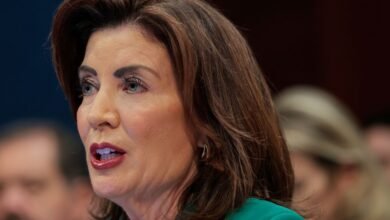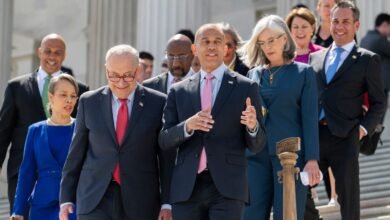
Donald Trump infamously said at the presidential debate he had the “concept of a plan” to replace Obamacare. As is often the case when Trump commits verbal self-harm, it fell to J.D. Vance to turn his car wreck of a statement into an intelligible position.
What Vance came up with is not only surprising but, if understood properly, far more damaging than Trump’s original statement. The Trump plan, according to Vance, is to permit insurance companies to discriminate against people with preexisting conditions.
Vance explained the Trump plan during an interview with NBC’s Kristen Welker: “He, of course, does have a plan for how to fix American health care, but a lot of it goes down, Kristen, to deregulating insurance markets, so that people can actually choose a plan that makes sense for them.”
Vance is advocating a partial or complete return to the system that existed before Obamacare. In that world, prior to 2014, it was very difficult to find affordable coverage unless you were on Medicare, Medicaid, or got insurance through your employer. There was a market for individual insurance, and it was possible to buy plans if you didn’t get coverage through a government plan or through work. But that market was dominated by “adverse selection” — the only way insurers could make money was to weed out any customers likely to need medical care.
Cheap plans could be sold to people who were young and healthy. Oftentimes, those plans denied coverage for any preexisting condition, or had hidden limits on the amount the insurer would have to pay, so if you got very sick, you would discover you faced ruinous costs not coverage by your insurance.
Obamacare turned that dysfunctional individual market into a market that offered affordable plans even for people who aren’t young and healthy. It did this by restricting the degree to which insurers can charge higher rates based on age (they can only make older customers pay a maximum of three times the rate they charge young customers). More importantly, it prevented insurers from screening out customers with a preexisting condition or denying coverage for necessary procedures.
Those regulations do have costs. They prevent insurers from cherry-picking young and healthy customers with cheap bare-bones plans — which means young and healthy people might pay more than they did before Obamacare. But it also means the individual insurance market actually makes coverage and medical available to people who need it.
In the early stages of Obamacare’s rollout, Republicans hoped and believed the ACA exchanges would collapse. Republicans predicted a “death spiral,” in which customers refused to buy insurance in the exchanges and rates went up, driving out more customers and causing rates to climb further, until the exchanges no longer functioned. That did not happen. More than 20 million people now get insurance through the individual market.
But at the time, Republicans fervently believed the death spiral would happen, and they devised a plan in response. The plan was to roll back Obamacare’s regulations. Insurers would be permitted once again to cherry-pick the market for young and healthy customers. Luring young and healthy customers into the markets with cheap plans, Republicans argued, would end the death spiral.
Republicans don’t talk about this idea much any more, because the basis for it (the Obamacare death spiral) has failed to occur and because letting insurance companies discriminate against people with preexisting conditions is horribly unpopular.
Vance tries to pitch this idea in the friendliest possible way, but the idea is unmistakable. Vance explains that Trump wants to:
implement a deregulatory agenda so that people can pick a health care plan that fits them. Think about it: a young American doesn’t have the same health care needs as a 65-year-old American. And a 65-year-old American in good health has much different health care needs than a 65-year-old American with a chronic condition.
We want to make sure everybody is covered, but the best way to do that is to actually promote more choice in our health-care system and not have a one-size-fits all approach that puts a lot of the same people into the same insurance pools, into the same risk pools, that actually makes it harder for people to make the right choices for their families.
Vance is correct that young people have different needs than old people, and healthy people have different needs than sick people, and putting them all in the same risk pool means charging young people more than they would otherwise pay. (Again, insurers can currently charge old customers up to three times the rate they charge the young — Vance thinks they should be able to charge the old even more.) What he doesn’t tell the audience is that allowing insurers to give cheaper plans to the young and healthy means letting them charge more — much, much more — to people who aren’t young and healthy. Perhaps some people have a member of their family who has an expensive medical condition. Those people would be unable to obtain decent coverage, as was the case before Obamacare.
Understanding health-care policy is a siloed journalistic skill, and Welker did not seem to recognize the radicalism of Vance’s plan. Instead, she summed up his answer, “What I hear you’re saying is Obamacare stays in place.” That is close to the opposite of what Vance said — he announced that Trump wants to reverse the regulatory protections in Obamacare that have made the individual markets affordable for people who have preexisting conditions or imperfect health records. Trump’s concept of a plan would take access to medical care away from millions of Americans.
Source link






